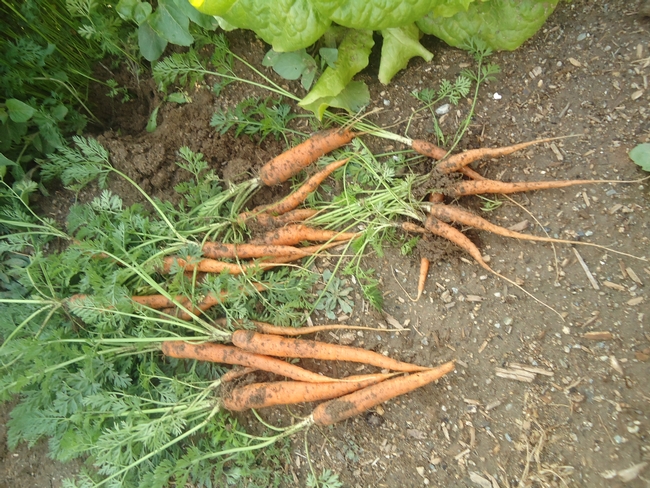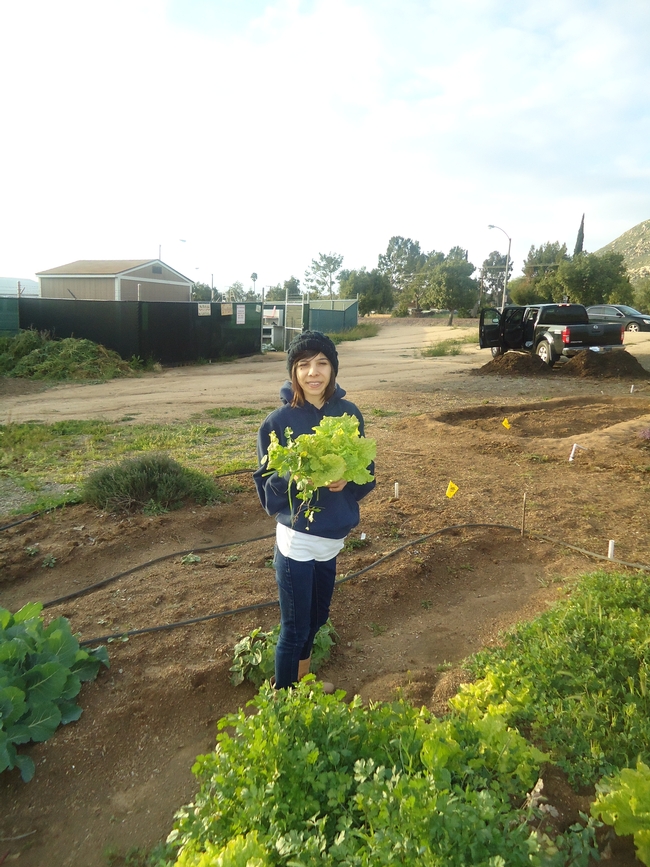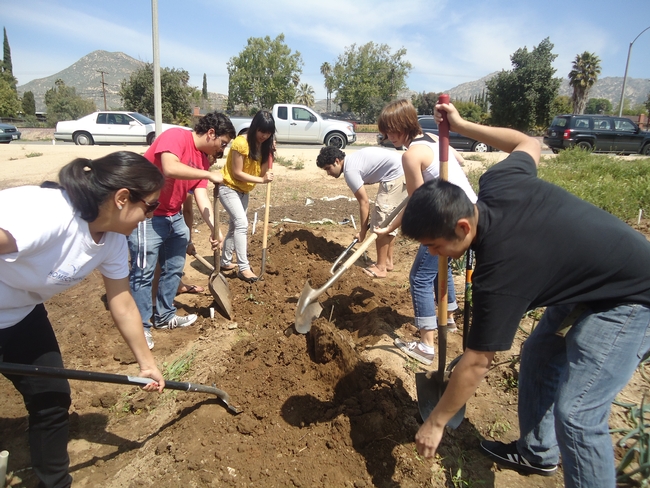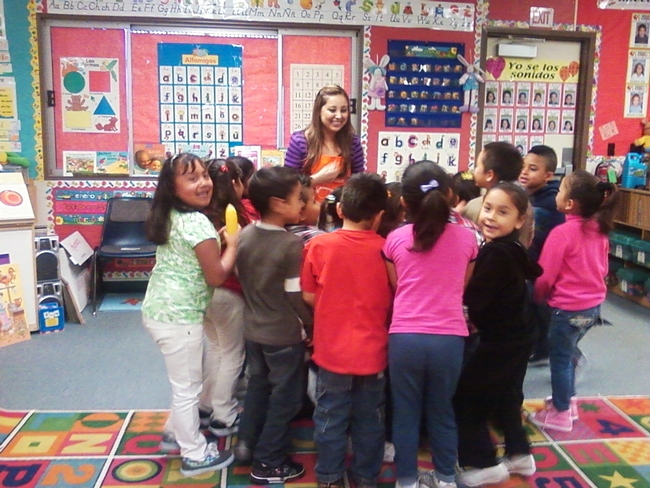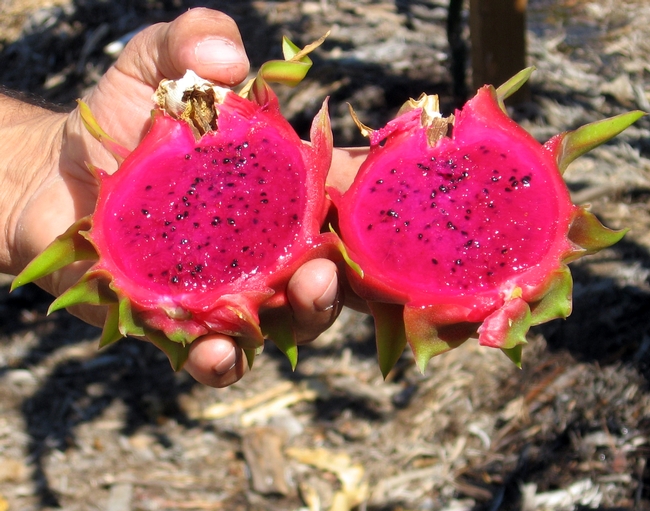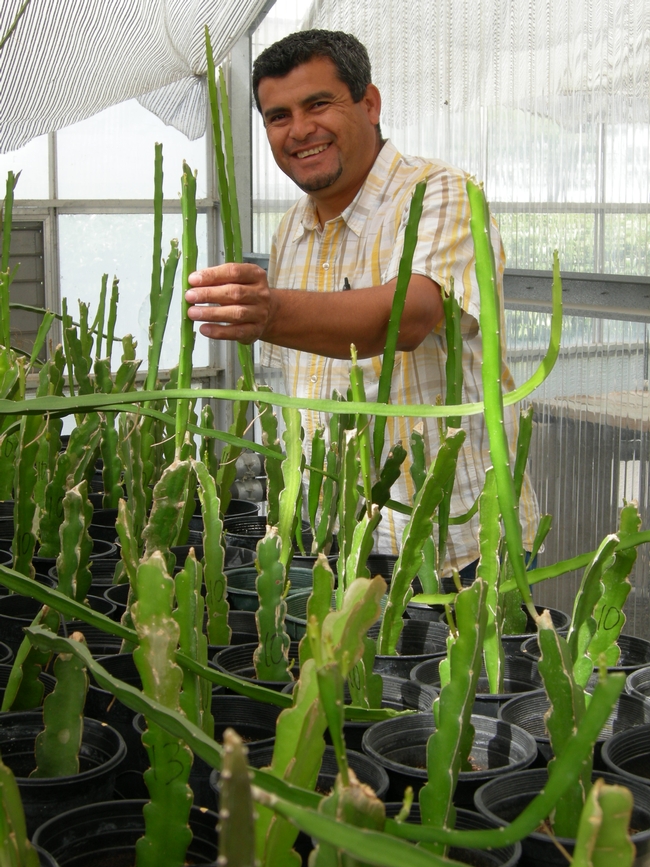UC Food Blog
A community garden takes root
Growing your own food. Raising awareness of food and environmental injustice. And creating a green community. These are the goals of the UC Riverside community garden initiative called Cultivate R-Space. At the community garden – a student-run “living experiment” that partners with UCR Sustainability – students grow and harvest their own food such as tomatoes, squash, potatoes and lettuce. Those who want just the experience of working in the garden grow flowers.
Located on campus, the nearly quarter-acre community garden has 20 plots to offer. Tools, water and seeds are provided at no charge to users. UCR Dining Services supplies the compost.
“It’s not as easy to work in the garden as it sounds,” cautions Cynthia De Leon, a junior who got involved in managing and using the garden last year. “It requires energy and a whole lot of passion. If anything, the garden teaches you how hard it is to grow food and exposes you to issues surrounding food and agriculture. Working in the community garden takes commitment, time and effort. To make sure interested students are fully dedicated, we ask that they first volunteer about two hours a week. If after a few weeks they continue to show an interest, we assign them a plot.”
A plan being worked out now by Cultivate R-Space is to allow faculty and staff to use the community garden for a small membership fee. The fees will kick in when the garden moves, in the very near future, to a location close to campus, occupying about an acre of land. Plans are also under way to get colleges on campus – the College of Natural and Agricultural Sciences, the College of Humanities and Social Sciences, and the Bourns College of Engineering – involved to promote research and hands-on learning about various social issues around agriculture and the modern food system. Serving as a learning platform, the community garden already is being used for soil science; the Science, Technology, Engineering and Mathematics (STEM) program; and Undergraduate Research in the Community.
“Our goal is not to feed everyone with this garden, and we understand we cannot grow food for all,” says junior Elizabeth Tizcareno, who also got involved with the garden last year. “This space is a model for tangible solutions that other communities in Riverside and elsewhere can adopt. The garden is an integral tool for researching how to develop sustainable neighborhoods. It is about developing a model that can be recreated elsewhere in order to sustain ourselves, our families, and live healthier and more equitable lives.”
The community garden has helped launch an Urban Garden Seminar at UCR that De Leon and Tizcareno facilitate. Held in the spring quarter, the weekly seminar includes a discussion of a food-related topic, guest speakers and field trips.
“The seminar has opened up an invaluable learning space – with hands-on experience – for students to learn about the garden and agriculture, as well as food injustice, such as the very high cost of some foods, occurring in Riverside and elsewhere,” Tizcareno says. “Food connects people and facilitates community formation. The goal of the seminar is that the students, even after they graduate, will create gardens in their communities for growing food.”
Both De Leon and Tizcareno plan to attend freshman orientation each year to spread the word about Cultivate R-Space and how it works with community-based organizations such as Growcology, a nonprofit in Riverside that creates sustainable programs, and Riverside’s Parks and Recreation Department. They hope to recruit many new users of the UCR Community Garden.
They plan, too, to take with them a sustainability award that Cultivate R-Space received in July 2011 from the California Higher Education Sustainability Conference: the Best Practice Award for Campus-Community Partnerships.
More information about Cultivate R-Space can be obtained by emailing sustain@ucr.edu or ucrurbangardenseminar@gmail.com.
UC-CalFresh supports school district menu changes through Nutrition Education
If you’ve ever asked a kindergarten student to flex their muscles, you know the smiles and giggles that follow. Their eyes grow wide when they learn about protein foods that help to keep their muscles strong. The UC-CalFresh Nutrition Education Program has the privilege of working with low-income students in Fresno County to combat childhood obesity through nutrition education.
Let’s look at a snap-shot of the health of Fresno County children. According to the CDC, 17.5 percent of children in Fresno County ages 2 to 5 years old are over the 95th percentile for their age. What does this mean? Over 21,000 young children are considered overweight. According to the California Department of Education, when compared with the statewide average* there is a greater percentage of 5th (36 percent), 7th (36 percent), and 9th (34 percent) grade students in Fresno County with an unhealthy body composition.
The numbers are jaw-dropping. What’s being done to combat these bleak statistics?
The Healthy, Hunger-Free Kids Act of 2010 has opened the door for improved menu changes to school breakfasts and lunches with increased funding for meals meeting updated nutritional standards. Examples of some of the new standards include: fat-free and low-fat milk, increased whole grains, a greater variety of colorful vegetables and offering juice that is 100 percent fruit juice.
The UC-CalFresh Nutrition Education Program works in close partnership with local school districts, food service directors, and over 900 Fresno County educators. In support of local school districts’ efforts to improve the nutritional value of the meals served, UC-CalFresh has come along side teachers to provide lessons, nutrition education materials, and healthy food demonstrations monthly. With a family-centered approach in mind, we further extend our reach through parent nutrition education classes and workshops.
At the University of California Cooperative Extension, our collaborative efforts are helping build and maintain healthy families and communities.
* Statewide averages in 5th, 7th and 9th are 32percent, 31 percent and 29percent, respectively.
Urban agriculture: An old model made new
Yesterday, I moderated a panel on urban agriculture at the annual meeting of the California Planning Association, which was held in Santa Barbara. The room was packed: urban agriculture is a hot topic these days. Micro-farms, backyard chickens, bee keeping, raw food markets all present challenges – and opportunities - for planners and communities. In our discussions yesterday, the idea of “scale” and definition came up frequently. The consensus of the panel? Within urban areas, urban agriculture should encompass everything from backyard gardens to commercial agricultural operations.
In practice, urban agriculture has been a persistent and organized activity in urban areas for well over a century. And one could argue that places like The Common in Boston make “urban agriculture” an even older model. Farming on the urban fringe - or even in the urban core, at some scale - has long been a feature of American life. Farmers markets are not a new feature of American life; they represent one of the oldest models of food distribution … from farmer direct to consumer.
The Panic of 1893, an economic downturn that brought distress to both urban and rural populations, was particularly difficult on Americans; there were few social safety nets for the poor and destitute. (Programs like Social Security and the Supplemental Nutrition Assistance Program – food stamps – came much, much later). The Panic of 1893 created a dangerous social climate in America, particularly in urban areas teeming with unemployed factory workers. The crisis brought to the fore a model of relief gardening that quickly took hold across the United States.
The “Potato Patch Farms” model, also called the “Detroit Experiment,” emerged under the leadership of Detroit’s mayor, Hazen Pingree. Pingree’s model connected hundreds of acres of vacant land in Detroit with unemployed workers and their families, who were provided with the materials, tools and education to garden the unused land. This was done in a systematic fashion. Pingree’s idea of ethical relief was met with strong resistance from many who believed that the unemployed – many of them immigrants – were too lazy to work. Skeptics, of course, were wrong: 3,000 families applied for the 975 allotments available the first year of the program (1894). The program grew during the next two seasons (1,546 families participated in 1895, 1,701 families gardened in 1896).
The city’s agricultural committee kept records of the investments made into the program and the value of crops harvested. In 1896, the value of food produced in Detroit’s potato patches was greater than the money provided to needy citizens by the “poor commission.”
The idea quickly spread to other urban areas: New York City, Buffalo, Philadelphia, Boston and Seattle were among the nineteen cities sponsoring vacant lot projects on some scale, according to an 1898 report. The model Pingree developed in Detroit was particularly innovative and visionary for its time; by the early 1900s, there was a national vacant lot cultivation organization that encouraged urban agriculture and city gardening. These programs clearly provided a rationale for the cultivation of vacant lots – “slacker land” - during the Liberty/Victory Garden effort in World War I.
To this historian, today’s economic climate feels quite a lot like 1893. And urban agriculture is once again coming to the fore as a viable, necessary and welcome addition to the food landscape. Detroit and many, many other urban areas, faced with issues created by depopulation, high unemployment, food deserts and other enormous challenges, are again looking at urban agriculture to provide solutions.
I applaud the dozens of planning professionals who attended this session, engaging in iterative discussions with panelists and other participants. These planners will play a vital role in creating public policies that support healthy and resilient food systems in our communities ... policies that acknowledge that increasingly, communities want more explicit connections with their food.
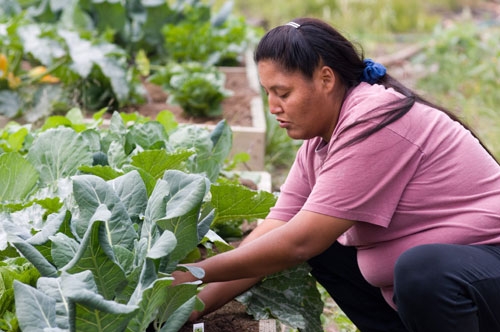
Micro-farms, backyard chickens, bee keeping and raw food markets are popular forms of urban agriculture.
Simple ways to make Latino food more nutritious
In the United States, Latinos account for 15 percent of the population, more than 47 million in all, but you can’t paint their impact on U.S. culture with a broad brush – especially when it comes to food. The Latino population is culturally and ethnically diverse.
Differences between Mexico, Puerto Rico and other Latin American countries stem from 500 years of separate histories, diverse native populations and their customs prior to the arrival of Spanish explorers. In order for nutrition educators to help Latinos maintain a healthy diet, messages should be tailored specifically to the Latino population residing in the particular geographical area.
In California, more than 80 percent of the Latino population is of Mexican descent. The Mexican diet is a blend of pre-Columbian, indigenous Indian, Spanish, French, and recently, American culture. Typically, the Mexican diet is rich in complex carbohydrates, which are provided mainly by corn and corn products, usually tortillas, present at almost every meal, beans, rice and breads. The diet also contains protein from beans, eggs, fish and shellfish, and a variety of meats, mostly pork and poultry. Traditional diets also reflect the geographic regions of Mexico and the availability of local fruits, vegetables, grains and dairy products.
There are simple ways to make traditional Mexican dishes healthier. Following are seven suggestions based on the 2010 American Dietary Guidelines:
- Substitute refried beans with whole black beans or pinto beans. Serve boiled beans instead of refrying them. For flavor, add spices like laurel leaves and other traditional spices.
- For refried beans, substitute lard, butter and shortening with olive oil or vegetable oil. These oils are free of trans fats and contain unsaturated fats, which help prevent cardiovascular disease by inhibiting the buildup of cholesterol in the body.
- Bake your own chips and use whole wheat tortillas to make them crispy and flavorful. This will reduce fat and calorie content.
- Grill or bake instead of frying to reduce the amount of oil you will ingest.
- For toppings, use plain yogurt instead of sour cream. There are some yogurts with the same consistency as sour cream. Add some chipotle, green onion and black olives to give flavor and make it attractive.
- Eat guacamole. Avocado (traditionally known as aguacate or palta) is cholesterol-free and potassium-packed.
- Use more spices – like cumin, peppers, paprika, chili sauces, garlic, cilantro and parsley – instead of salt. Keep salt consumption to less than one teaspoon per day. High salt consumption is linked to increased risk of high blood pressure and kidney disease.
The use of sugar and other caloric sweeteners – such as honey and high-fructose corn syrup – should also be minimized. They contribute to an increased risk of chronic disease, such as cardiovascular diseases and diabetes. The consumption of sugary sodas is very common in the Latino community. Some changes to reduce sugar consumption include:
- Drink water instead of sodas. Add flavor to water by adding mint, parsley, cucumber or lemon slices.
- Drink more aguas frescas; use fruits like pineapple, watermelon, melon, guava, mango. Add some cinnamon for flavor and to reduce the amount of sugar.
- Children should eat cereal without added sugar. Instead they can eat hot cereal and add seasonal fruit like apples, peaches or strawberries.
- Prepare fruits as dessert. Bake apples, serve bananas sprinkled with cinnamon and walnuts, watermelon with chili and lemon, and papaya with lemon.
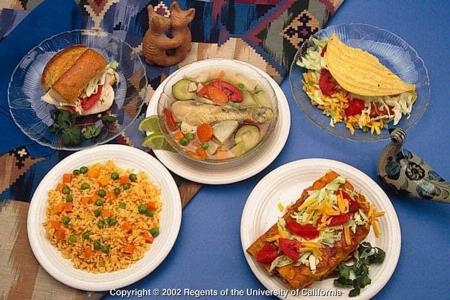
Examples of traditional Mexican food.
You should taste it fresh
Question: What exotic fruit has been named as a flavor in Starburst candy, Ice Breakers gum, SoBe beverages, Vitamin Water drinks, Bacardi rum and even Axe body spray?
Answer: Dragon fruit. (Hylocereus spp.)
So while many of us may have tasted products that flaunt its name, have you ever sunk your teeth into a fresh dragon fruit?
If you want to try one, you may be in luck because now is the peak harvest season in Southern California for this subtropical cactus fruit with the fire-breathing name — also known as pitahaya. And it just so happens that growing and eating fresh dragon fruit is what Ramiro Lobo, UC Cooperative Extension farm advisor for San Diego County and the Small Farm Program, is most interested in.
Lobo says he’s known about pitahaya since he was a kid, but his professional interest was rekindled when the enthusiasm of the Rare Fruit Growers group intersected with an ongoing quest to find crops that are more water-efficient for the region.
“Wherever you can grow Hass avocados, you can grow dragon fruit,” he said. “And it uses less water than avocados or any other orchard crop that we grow in San Diego.”
Though this used to be a fruit found only rarely in specialty stores, Lobo says that is changing.
“We’ve seen the market expanding. We’re seeing it in high-end restaurants in Los Angeles and Las Vegas,” he said. “Supply is very sketchy right now, but growers who are selling direct at farmers markets are getting $7-8 per pound. Hardly any other fruit today is bringing that kind of money.”
One other clue that the U.S. market for this “artichoke from Mars” (as one LA Times writer described it) is expanding? Imports of the fruit have been growing from Vietnam, with perhaps 600 tons imported in 2010. And the USDA is currently working through the processes that could allow imports from Mexico, Thailand and Central America too.
While Lobo doesn’t sound too worried about competing with imported dragon fruit, he does hope your first taste of fresh dragon fruit is indeed very fresh.
“We cannot compete with Vietnam fruit for price, but we can definitely compete for quality,” he said. “The challenge is that a lot of people are exposed to dragon fruit, but the fruit quality is lousy. It’s a very sensitive fruit, so if you put it in a container and send it across the ocean for 10 days, it’s not going to be as good. But people who get exposed to a good variety keep buying it.”
In California, it is estimated that about 200 acres are planted in pitahaya, with anywhere from 400 to 1,000 acres planted nationwide.
Lobo oversees approximately 500 dragon fruit plants at the UC South Coast Research and Extension Center in Irvine. He is currently working to set up an irrigation trial for pitahaya, to better evaluate its water requirements. He is also working to test out different trellis systems, comparing hedge versus orchard systems for this fruiting cactus.
The UC South Coast Research and Extension Center is also where the pitahaya field day was held recently. Lobo said questions from the day’s 100 or so participants sounded like more growers are getting serious about growing pitahaya commercially, with more technical questions and an interest in disease, rodent and pest management.
“The bar has been raised, and [some of those questions] even put us in a bind because without the research, it is kind of hard to answer them,” he said.
In the meantime, Californians and marketing companies will probably continue to find new secondary uses for this fruit’s juice, pulp and name: Lobo says he’s seen wines made with dragon fruit and organic yarn dyed naturally with that fiery pink flesh.
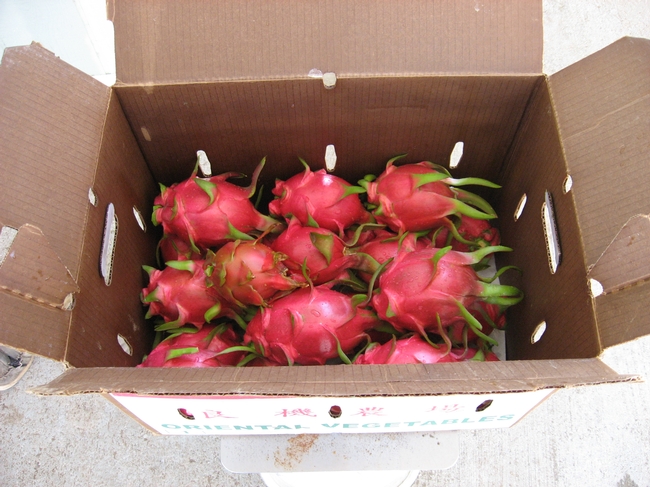
Pitahayas, as packed at a small farm in San Diego. (Photo by Shermain Hardesty)
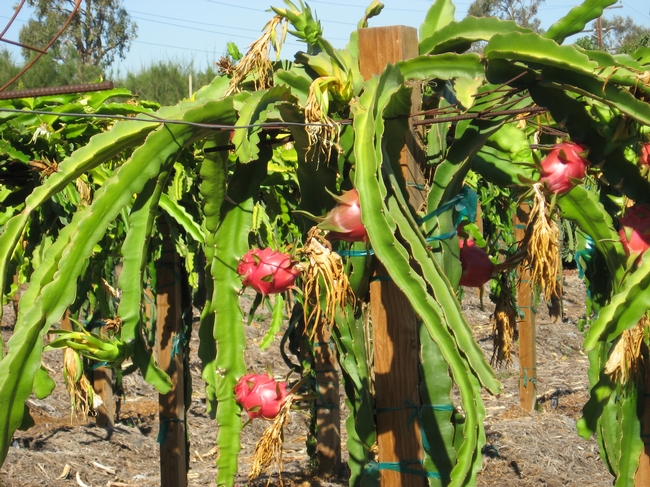
At UC South Coast Research and Extension Center, the dragon fruit plants are currently in an orchard system, though new trellis trials will soon be under way. (Photo by Shermain Hardesty)
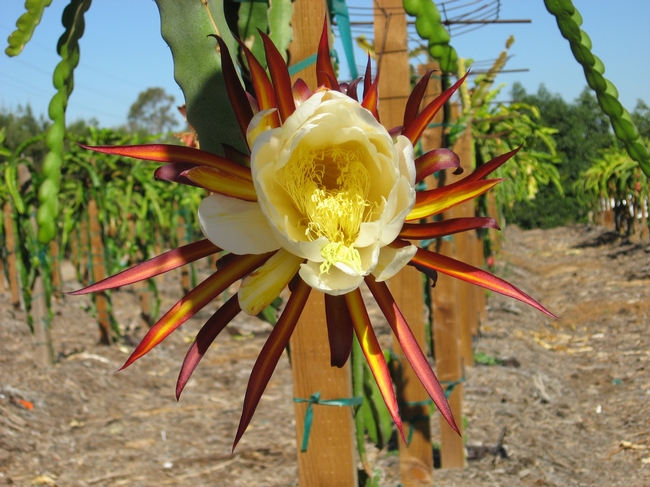
Pitahaya blooms at UC South Coast Research and Extension Center. (Photo by Shermain Hardesty)
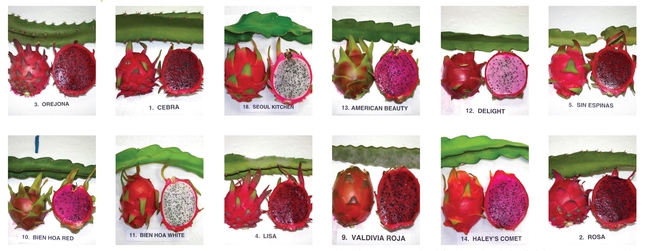
Colors of ripe pitahaya flesh can vary between red, fuschia, pink and white.
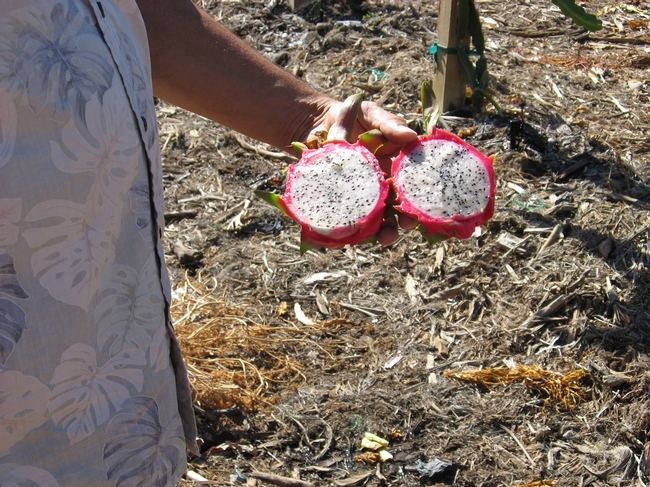
Irvine Field Station white flesh pitahaya


